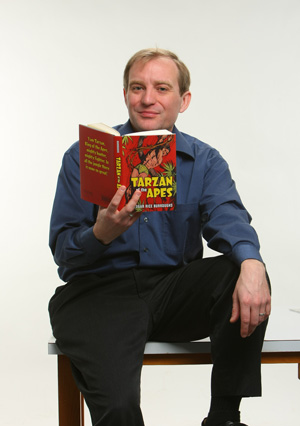 |
| Jason Haslam is editing a new edition of Tarzan of the Apes.ŐżŐż(Danny Abriel photo) |
Whenever a new Disney or Lucasfilm blockbuster comes out, it’s a given we’ll see the characters appear in comics, toys, books and video games. It’s the kind of cross-cultural pollination that’s kept Star Wars successful for over 30 years.
But savvy marketing isn‚Äôt new. Tarzan‚Äôs creator, Edgar Rice Burroughs, helped invent the media blitz. ‚ÄúHe was a very canny marketer and publicist,‚ÄĚ says Associate Professor of English Jason Haslam. ‚ÄúTarzan was one of the first ‚Äď if not the first ‚Äď mass marketed figures.‚ÄĚ Burroughs was fantasy fiction‚Äôs original multi-media impresario and his shrewdness kept Tarzan at the heart of popular culture for nearly a century.
The volume of Tarzan tales is mind-bogglingly large, even by today’s standards. He first appeared in a magazine in 1912. That was republished as a novel, Tarzan of the Apes, in 1914. Four years later, the first Tarzan movie grossed $1 million. Burroughs swiftly incorporated himself into ERB, Inc. to control the brand. He even named his California ranch Tarzana. A Sunday comic strip appeared in 1929 (drawn by Halifax native Hal Foster), followed by a radio serial in 1932. Burroughs cranked out 25 more Tarzan novels in his lifetime and by the end of the ’60s, almost 50 Tarzan movies had been made.
Everybody knows Tarzan. But do they? Dr. Haslam recently edited an Oxford University Press edition of Burroughs’ 1914 novel, Tarzan of the Apes. What interests him is how Tarzan became such a massive pop icon yet could still divorce himself from his original context.
‚ÄúIt‚Äôs a fascinating moment where a character like this can be made into a Disney film and somehow try to escape its own racist background,‚ÄĚ Dr. Haslam says.
Wait. Maybe we don’t know Tarzan as well as we think.
‚ÄúThe novel is simply racist. There are no ifs, ands or buts about it,‚ÄĚ Dr. Haslam says pointedly. If you revisit Tarzan of the Apes, what strikes you first is its brutal stereotypes of Africans and a plot fueled by sensational African explorers‚Äô tales and absurd racial theories.
Dr. Haslam asked himself many times during the project why he would want to edit such a problematic novel. Would he be perpetuating its problems, or redressing them with a critical edition?  
‚ÄúI don‚Äôt know if I walked that line or not,‚ÄĚ he says, ‚Äúbut I read it as a child myself, and I wanted to at least give kids like me the ability to go back and see through the introduction or through the notes, that there are these issues and they can think about them rather than just ignore them.‚ÄĚ
Dr. Haslam‚Äôs edition differs from previous editions in important ways. The book has an introduction that frankly discusses racism in the novel. His edition includes a selected critical bibliography, a chronology of Burroughs‚Äô life and ‚Äď most importantly ‚Äď an introduction he wrote that explores the history, social tensions, and problems with the novel.
While open racism was more socially acceptable in 1914, Dr. Haslam doesn’t consider the past the only guilty party. Even at the time that Burroughs wrote Tarzan of the Apes, suffragettes and the NAACP were emerging as significant social forces. He drew inspiration from a variety of ever-popular American cultural touchstones to idealize Tarzan’s machismo as the Great White Hunter: anti-imperialism, the Boy Scouts, a nascent body building culture and a back-to-nature movement reacting against the emasculating culture of industrial America. It’s too easy to lay blame at the foot of history. 
‚ÄúWe need to recognize it as a part of history but not excuse it on that basis,‚ÄĚ he says. The edition includes entertaining letters published in All Story magazine in 1912 responding to the Tarzan story. Many complain about the failed romance between Tarzan and Jane. Race isn‚Äôt a concern in these letters. Today, we can‚Äôt help but place Burroughs‚Äô treatment of race under the microscope.
He teaches the book in a first-year pop culture class at Ľ∆…ę÷Ī≤•. Students oscillate between giggling at the ham-fisted romance and dropping their jaws at the jingoistic stereotypes, but again, Dr. Haslam believes Tarzan is worth more than laughs and groans.
What is interesting about pop culture, he says, is that people think it’s simple entertainment, but there’s nothing simple about it. What makes Tarzan useful to him as a teacher is that the problems with the book force his students to reflect on the problems in today’s pulp fiction.
‚ÄúWhat about texts in our own time that might have problems like that, problems that might seem almost invisible to some of us? Can we use Tarzan to see how problematic, racist assumptions are encoded into texts? Sure, we can all see it in a book from 100 years ago ‚Äď but what about those popular texts 100 years from now that people will have a hard time believing some of us could read today?‚ÄĚ
Of course, Dr. Haslam believes many things have improved since Burroughs‚Äô day. We‚Äôre just a long, long way from perfect. ‚ÄúWe‚Äôre all born within a culture and we can be ignorant of its problems, unless we‚Äôre being critical readers. I want my students to be critical readers.‚ÄĚ
With a new edition of Tarzan of the Apes on the shelves for next year’s class, they ought to be well on their way.
